


Every avid mountain biker knows the feeling of speed — the wind blowing through their hair, the feeling of gliding over rough terrain. If you’re ready to push your limits and leave a trail of dust behind you, you’re ready for an exciting journey.
In this guide, we’ll reveal the secrets to turning your mountain bike into a speedy beast, ready to tackle any road with lightning-fast precision.
From optimizing your bike’s components to improving your technique, there are plenty of ways to harness the wild power of your two-wheeled companion. Whether you’re chasing the best or just trying to improve your driving experience, the excitement awaits with a boost in speed.
Join us as we explore the world of bike modifications, training, and advanced training. From aerodynamic settings to body positioning techniques, we’ll walk you through the steps to get you into the world of top speed.
Get ready to step up your mountain biking game and make your mark in the incredible crowd. Let’s dive into the finer details of how to make your mountain bike go faster with one exciting pedal stroke at a time.
Read More: Can you ride a mountain bike on the pavement?
Tuning Your Ride for Speed: Enhancing Bike Components
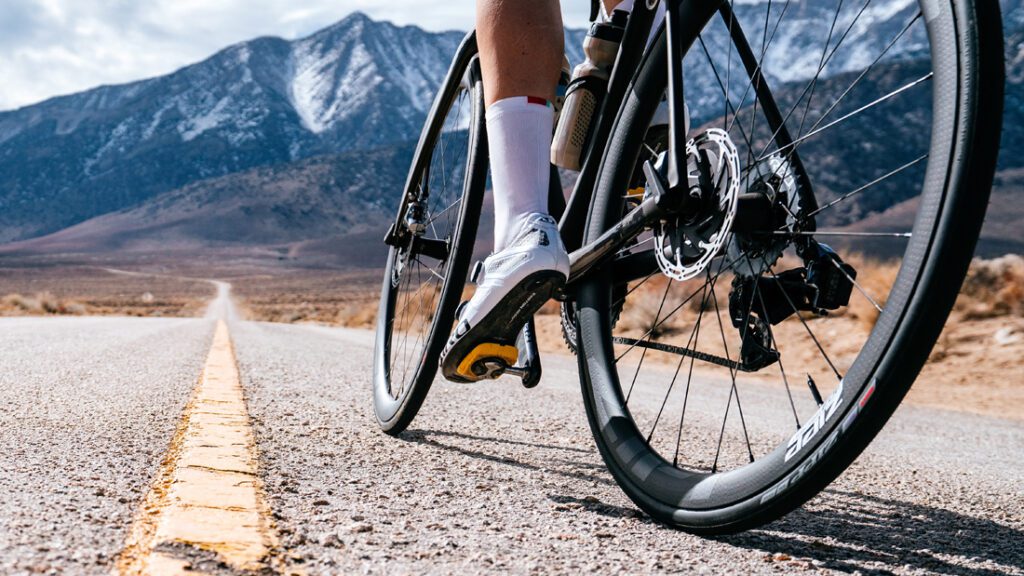


Every little tweak and improvement can make a big difference when it comes to unlocking your mountain bike’s full-speed potential. Upgrading your bike’s components is like upgrading precision instruments, ensuring that every pedal stroke results in an increase in speed.
Read More: Why are mtb seats so uncomfortable
Whether you’re a professional rider or an adrenaline junkie, optimizing your bike’s performance can improve your riding experience.
- Speed Wheel:
Install a lighter aerodynamic wheel that reduces spin weight for faster acceleration and smoother turning in any terrain.
- Precision Pedals:
High-performance, secure-grip pedals not only improve power transfer but also improve your control by delivering efficient power transfer.
- Smooth Shifting:
A well-maintained smooth-shifting transmission allows you to maintain speed on rough roads with minimal loss of energy.
- Braking Performance:
An advanced braking system provides better modulation and braking power, giving you the confidence to maintain higher speeds while maintaining safety.
- Aerodynamic Cab:
Sleek ergonomic handlebars, stem and handlebar reduce wind resistance, helping you cut through the air more efficiently.
- Lightweight Frame:
Investing in a lightweight frame while maintaining durability reduces the overall weight of the bike, making climbing easier and accelerating faster.
- Tire choice is important:
Choose tires that provide maximum grip without sacrificing speed, have lower rolling resistance, and have a tread pattern suitable for the terrain.
- Suspension Tuning:
Adjusting suspension settings to suit your driving style improves handling and stability, allowing you to maintain higher speeds in difficult times.
- Careful Maintenance:
Regular maintenance keeps your bike in top condition by minimizing friction and ensuring that all components work flawlessly.
- Driver Tip:
Finally, remember that your driving technique plays an important role. Correct body position, smooth pedaling, and efficient cornering technique contribute to higher speed.
By focusing on these key aspects and taking a holistic approach to bike design, you’ll be well on your way to building a fiendish mountain bike that’s ready to take on any road with unwavering speed. Prepare, adapt, and let the wind carry you as you ride faster than ever.
Read More: How to ride switchbacks on a mountain bike.
Aerodynamics Unveiled: Streamlining Your Mountain Bike



Speed is a huge sensation in the mountain biking world. Any effort spent pedaling must be converted into quick movement. Explore the realm of aerodynamics, the science of reducing wind resistance, and the decisive factor in improving the performance of your mountain bike.
Related: How to make your mountain bike faster
You can transform your car into an economical, medium, and fast car by using all the power of aerodynamics.
- Use a wind tunnel:
Use a wind tunnel or even a simple DIY test to understand how your body and bike interact with air resistance. Fine-tune body position and bike geometry.
- Stylish Equestrian Clothing:
Choose aerodynamic clothing that fits snugly and minimizes drag. A leather suit, aero helmet, and gloves can all contribute to a slimmer profile.
- Get rid of the excess:
Remove unnecessary accessories or equipment that create additional wind resistance. Get the most out of your bike by choosing smooth, breathable components.
- Change wheels:
Invest in wheels with a deep section and aerodynamic properties. They can significantly reduce friction and provide a noticeable increase in speed.
- Handlebars and Stems:
Opt for aero handlebars that provide a more aggressive stance and reduce frontal space. Complete with a slim body.
- Geometric Frames:
Choose a frame with a geometry designed to cut through the air. This may include a lower front end, a longer upper tube, and a narrower tube.
- Tire selection:
Choose tires with minimal tread patterns to reduce rolling resistance and improve aerodynamics. Wider tires at low pressure can also provide smoother airflow.
- Fluid Dynamics:
Make sure the hydration system, bottles, and cage are positioned to minimize airflow interruption around the bike.
- Driver Position:
By lowering your body, bending your elbows, and keeping your profile straight, you reduce your aerodynamic footprint and increase your speed.
- Training Challenges:
Use techniques like establishing and maintaining a steady pace to optimize your speed while cycling.
- Be aware of the wind:
Pay attention to the direction of the wind and adjust your driving strategy accordingly. Going against the wind and maintaining a lean body can make a big difference.
By immersing yourself in the world of aerodynamics and making conscious choices to optimize your mountain bike and riding style, you will experience the thrill of gliding in the wind. Unleash the aerodynamic power and watch your mountain bike become a force to be reckoned with, splitting the air and leaving a trail of speed behind it.
Read More: Does biking help lose belly fat?
Pedal Power: Optimizing Efficiency for Faster Riding
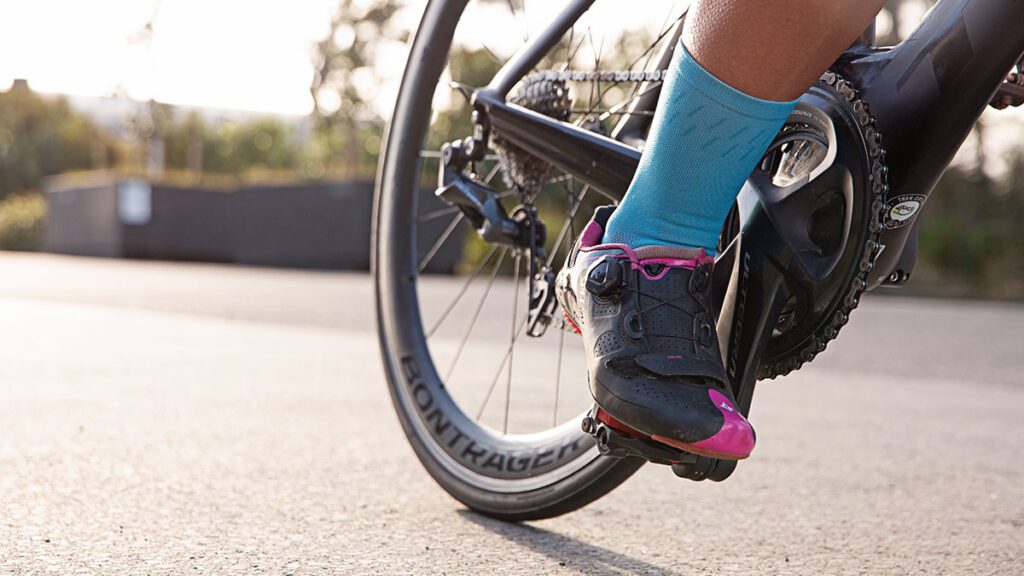


Every pedal stroke on a mountain bike is an opportunity to pick up speed and move on. Maximizing pedaling power isn’t just about brute force; it’s about perfecting your technique, understanding the mechanics of your bike, and using your energy efficiently.
In this article, we’ll explore the world of power pedaling and find out how you can optimize your efficiency for faster, more exciting rides.
- The Science of Pedaling:
Learn about the biomechanics of push-to-push pedaling and how to use each stroke for optimal power transfer.
- Perfect pedaling technique:
Learn techniques such as pedal placement, maintaining a circular pedal stroke, and correct foot position to increase pedaling power.
- Mastering Rhythm:
Learn how cadence (pedal revolutions per minute) affects your efficiency and speed, and learn how to find the ideal cadence for different terrains.
- Gear Efficiency:
Learn how proper gear ratios can increase pedaling power and allow you to maintain higher speeds with less effort.
- Climbing Strategy:
Master the art of efficient climbing by adapting your pedaling, cadence, and shifting techniques to overcome the difficulties of climbing uphill.
- Proper descent:
Learn to use the power of the pedals downhill, maintain control and use the pedals to maintain acceleration.
- The balance between effort and energy:
Understand the balance between effort and energy savings and how to manage your efforts at a sustainable pace.
- Core and Upper Body Engagement:
Explore the role of the core and upper body in generating power and balance while pedaling and optimizing overall efficiency.
- Breathing technique:
Look for efficient breathing patterns that maintain cadence and increase oxygen uptake and retention.
- Mental focus:
Explore the psychological aspects of pedal power, from maintaining focus during the intense effort to visualizing efficient pedal strokes.
- Cycling fit and comfort:
Learn how proper cycling fit provides optimal biomechanics, relieves stress, and enhances your ability to generate power while pedaling.
- Training and conditioning:
Explore non-riding exercises and routines that target the muscles needed for powerful pedaling.
- Monitoring and Feedback:
Make data-driven improvements using technologies such as power meters and cadence sensors to monitor and analyze pedal power.
- Put it all together:
Develop a holistic approach that combines technique, gear selection, fitness, and mental strategy to achieve maximum pedal power.
As you step into the realm of pedal power optimization, you’ll discover new speed and efficiency with every ride. By honing your technique, making conscious gear choices, and focusing on overall improvement, you’ll experience the joy of faster riding and the satisfaction of mastering the art of pedaling power.
So get ready, pedal smart, and watch your mountain biking ride reach a new level of speed and excitement.
Read More: Is mountain bike good for long rides
Gearing Up for Speed: Choosing the Right Ratios
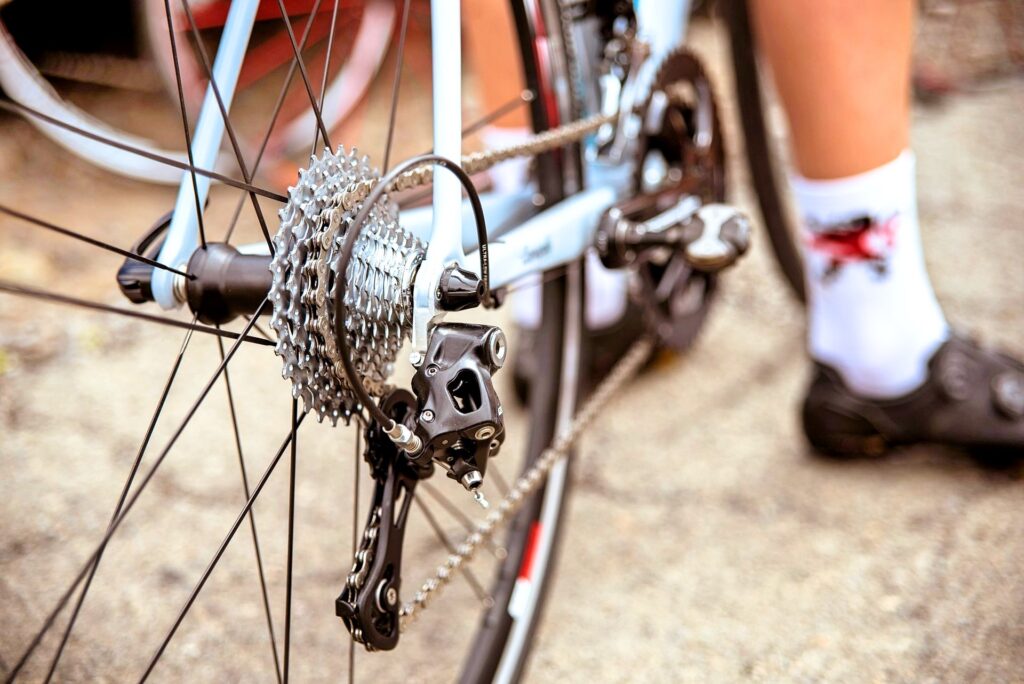


When it comes to making your mountain bike faster, one of the most important things to consider is choosing the right gear ratio. The right gear ratio can make a huge difference in your bike’s performance and speed.
Let’s get into the details of how to optimize gear ratios for faster and more efficient driving.
- Understanding gear ratios:
The gear ratio determines the ratio between the number of teeth of the front sprocket and the number of teeth of the rear cassette. The lower gear ratio provides more torque, ideal for climbing, while the higher gear ratio provides higher speed on flat ground or downhill.
- Finding the Right Balance:
Choosing the right gear depends on your driving style and the type of terrain you travel frequently. Experiment with different gear ratios to find the right balance between pedal efficiency and speed.
- Consider the rhythm:
Cadence, the number of pedal revolutions per minute, plays an important role in optimizing gear ratios. A higher cadence can help maintain momentum and reduce fatigue on long rides.
- Climbing Efficiency:
For climbs, choose a lower gear ratio that makes it easier to pedal. This reduces muscle tension and allows you to overcome steep inclines more efficiently.
- Speed on straights and downhill:
On level ground or downhill, the higher gear ratio enables higher speeds to be achieved with less effort. This is important for maximizing your bike’s potential.
- Fine-tuning with forward and backward:
The strategic combination of forward and reverse gears allows you to fine-tune the gear ratio for specific conditions. Adjusting gears while driving can optimize your performance.
- Try and adapt:
The ideal gear ratio can vary depending on factors such as track conditions, your fitness level, and bike settings. Experiment with different ratios and see how they affect your speed and power consumption.
- Seek advice from an expert:
Consulting a bike mechanic or experienced cyclist can provide valuable information for choosing the right gear ratio. Their experience can help you optimize your bike’s performance.
As a result, choosing the right gear ratio is an important step in increasing the speed and efficiency of your mountain bike. By understanding the relationship between gear ratios, cadence, and terrain, you can tune your bike for optimal performance and enjoy faster, smoother rides.
Read More: Which bike gear for uphill
Trailblazing Techniques: Body Positioning for Maximum Velocity
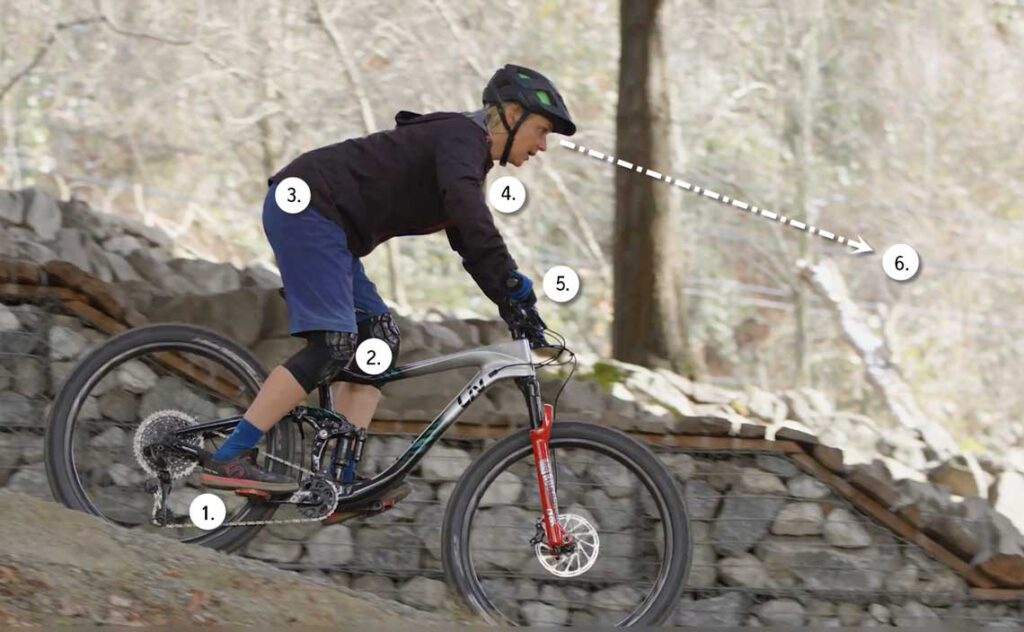


When it comes to mountain biking, mastering the art of positioning can make a huge difference in your speed and control on the trail. Your body is not just a cyclist; It’s an active player who can influence the way you overcome obstacles, turn and reach top speed.
In this article, we’ll explore upper-body positioning techniques that will help you pioneer as you accelerate to new levels of speed and pleasure.
- Attack Stance:
Learn the basic attack stances that form the basis for optimum body position. By balancing your body weight between the front and rear wheels and slightly bending your knees and elbows, you are ready to react quickly to changes in the terrain.
- Weight Distribution:
Learn how to vary your weight to adapt to different terrains. Increase traction and stability by using your body to shift your weight forward on the climb and backward on the descent.
- Confidence in bends:
Master the technique of tilting the bike while precisely maintaining an upright body position on bends. This technique minimizes the risk of slipping and helps maintain speed on turns.
- Downhill Control:
Learn to lower your center of gravity and stand on the pedals with your knees slightly bent as you descend. This crouched position maximizes stability and control, allowing you to descend safely and quickly.
- Uphill Courage:
Master the body position adjustments required for hills. Shift your weight forward to maintain traction on the front wheels and keep your chest down to open your airways and make breathing easier.
- Pumping Techniques:
Learn the art of pumping a bike over rollers and terrain. You create forward momentum by using your body to apply pressure to the bike’s suspension when approaching a slope, then bouncing back as you go up.
- Technical Trail Talent:
Cycle through technical sections with agility, using body position to lighten the bike’s weight while navigating through obstacles like rocks and roots. This minimizes impact and allows your wheels to slide over obstacles.
- Jump Dynamics:
Understand how to position your body during a jump, from preload to takeoff and landing. Proper body position improves control and maximizes your ability to take off and soft landing.
- Line selection and vision:
Combine body position with effective line selection and vision. Stay on track and adjust your body to optimize your route and maintain your speed.
- Progressive Learning:
Practice and improvement are essential. Start by learning basic body positions on the easier trails before moving on to more challenging terrain. As you gain confidence, challenge yourself with advanced techniques.
- Riding Rhythm:
Develop a smooth riding rhythm that seamlessly integrates body movement with cycling movement. This synchronization increases momentum and speed.
- Consistency and relaxation:
Maintain a consistent body position and stay comfortable on the bike. Consistency fosters confidence and efficiency, while tension suppresses fluidity and control.
- Monitor feedback:
Listen to the feedback your body gets from the piece. Adjust your body position according to how the bike responds to different terrain and obstacles.
- Mental Focus:
Combine physical techniques with mental focus. Visualize the road ahead, anticipate changes, and proactively adjust body position.
Once you master this innovative body positioning technique, you’ll unlock a whole new level of mountain biking prowess. Whether you’re beating a technical section, going downhill, or skating, your body position will be your secret weapon for ultimate speed and control.
Enhance your riding experience, push your limits, and lead every mountain bike adventure.
Read More: Is mountain bike good for beginners
Training for Velocity: Building Strength and Endurance
Achieving high speeds on a mountain bike requires more than just hard pedaling—it requires a strategic approach to training that includes both physical and mental aspects. Whether your goal is to conquer the descents or gain strength on difficult climbs, a comprehensive training program is essential to develop strength and endurance.
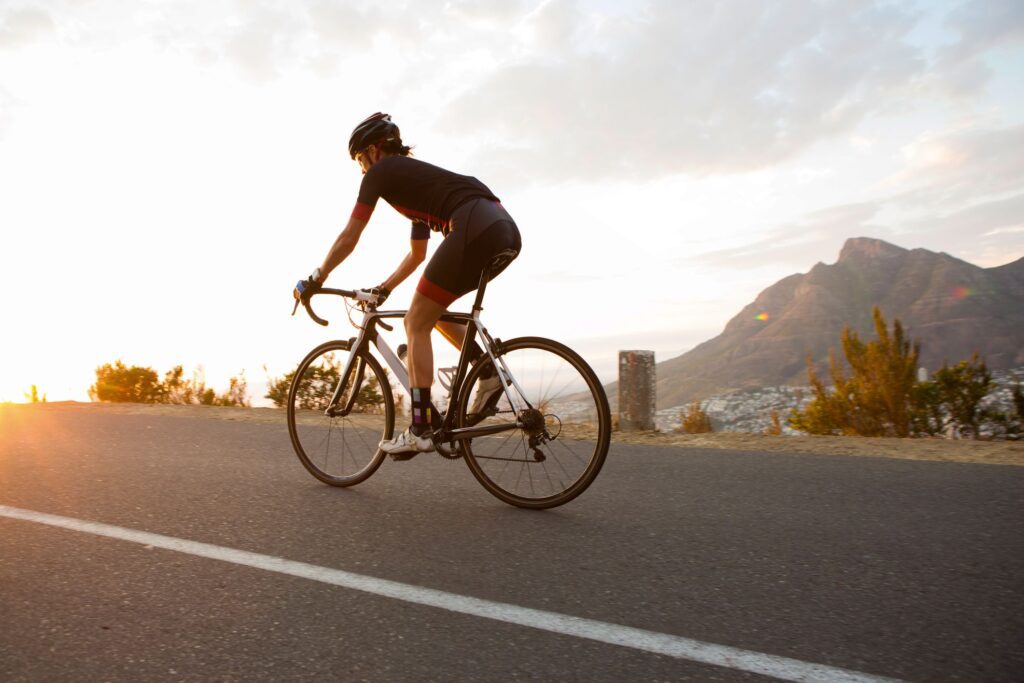


In this article, we will introduce you to the basic training elements that will help you increase your speed and endurance on the track.
- Cardiovascular system:
Start by improving your cardiovascular system through activities such as cycling, running, or swimming. A strong heart and efficient lungs are the basis for sustaining a high intensity of effort.
- Interval training:
Make interval training part of your routine. Alternate periods of hard pedaling and rest to increase anaerobic capacity and overall speed.
- Strength training:
Strengthen your muscles with targeted exercises like squats, lunges, deadlifts, and core exercises. A variety of strength training improves pedaling power and stability.
- Plyometrics:
Incorporate plyometric exercises like box jumps and explosive squats to develop the fast twitch muscle fibers needed for fast acceleration and bursts of speed.
- Uphill Reps:
Challenge uphill reps to improve your climbing skills and leg strength. Climbing steep slopes repeatedly challenges your muscles and helps you build the strength you need for long climbs.
- Long ride:
Gradually increase the duration of the long ride to increase your endurance. This ride mimics the demands of a long walk, preparing your body for the rigors of a long ride.
- Rhythm training:
Practice continuous effort at a challenging but steady pace. Tempo training improves your ability to maintain a steady pace for extended periods.
- Rhythm Work:
Develop a higher cadence (pedal revolutions per minute) through rhythm practice. Higher cadence means higher speed, resulting in a smoother, more efficient ride.
- Recovery and rest:
Prioritize recovery days to allow your body to adapt and strengthen. Quality sleep and proper nutrition are essential for optimal recovery.
- Mental Focus:
Train your mind to stay focused and stay positive during a tough ride. Mental endurance plays an important role in maintaining speed.
- Cycling Skills:
Improve your cycling skills to maneuver quickly and confidently on technical sections. The combination of agility and speed makes for a smoother ride.
- Nutrition and hydration:
Fuel your body with proper nutrition and stay hydrated to maintain energy levels and maintain performance during intense commutes.
- Periodize your workouts:
Intense periods followed by rest periods to avoid fatigue and achieve incremental improvements.
- Setting goals:
Set clear training goals for yourself, whether it’s reaching a certain speed, overcoming a difficult course, or finishing a race. Goals provide direction and motivation.
- Consistency:
Consistency is the key to long-term progress. Stick to your training plan, stay committed, and keep improving your technique.
When you incorporate these training principles into your regimen, you will see a noticeable increase in speed and endurance when riding a mountain bike. Remember that increasing speed and power is a gradual process that requires commitment and patience.
Go on a journey, celebrate your achievements, and watch your performance on the slopes grow.
Read More: Best fat bike tires for pavement
Mastering the Downhill Dash: Utilizing Gravity for Speed



Few thrills can compare to the steep descents of a mountain bike that uses the force of gravity to reach incredible speeds. Downhill riding requires a unique set of skills and techniques to maintain control and maximize speed as you navigate rough terrain.
Read More : ” Specialized Rockhopper 27.5 Review “
In this in-depth guide, we dive into the art of mountain biking, learning strategies, and tips to help you master the downhills and experience the thrill of speed like never before.
- Position of the body:
The basis of the advantages of downhill riding is the correct position of the body. Stay low and centered on the bike with your elbows bent and knees slightly bent. This squatting position lowers the center of gravity and improves balance.
- Forward Vision:
When looking ahead, focus primarily on roads and obstacles. Predicting what will happen allows you to adjust your trajectory and choose the smoothest trajectory.
- Braking technique:
Effective braking is important. Use your front and rear brakes wisely and apply them evenly to prevent slipping. Apply the brakes to control the speed without locking the wheels.
- Weight distribution:
Change your body weight as needed – backward on steep slopes to avoid rolling over the handlebars, and forwards to maintain traction when overcoming obstacles.
- Turning skills:
Master the art of cornering by tilting the bike, not your body, to corner. Outer foot down, inner foot up, and outward gaze are the principles that provide optimum balance and speed in turns.
- Path selection:
Choose your path carefully to find the smoothest and fastest path. Avoid obstacles whenever possible and use ledges and natural elements to your advantage.
- Bike Setup:
Set up your bike for downhill. Adjust suspension settings, and tire pressure, and consider adding seat posts for more agility.
- Mental Focus:
Be focused and relaxed. A calm mind helps you make snap decisions and react effectively to changing circumstances.
- Exercise and progress:
Start on the easier path and gradually work your way up to the harder path as your skills improve. Confidence comes with practice.
- Protective Equipment:
Safety comes first. Wear a full-face helmet, padding, and appropriate protective equipment to protect yourself from possible impacts.
- Maintain your bike:
Bicycles in good condition improve performance and safety. Check the brakes, tires, suspension, and transmission components regularly.
- Uphill technique:
Efficient climbing techniques form the basis of exciting descents. Learn to climb efficiently to access the best descents.
- Respect the trace:
Always respect the trace and follow the Zero Trace principle. Protect the environment for future drivers.
- Learn from others:
Join group outings, clinics or seek advice from experienced cyclists to improve your downhill skills.
- Accept progress:
Downhill riding is a way of continuous improvement. Brave challenges, celebrate small victories and experience the thrill of mastering downhill.
By following these tips and tricks, you’ll discover a new dimension of mountain biking that will let you use gravity to accelerate and experience the pure joy of conquering the trails with agility and confidence.
Remember that practice, patience, and a hunger for improvement will help you master the inclines.
Related: How to get better at downhill mountain biking
Fine-Tuning Your Technique: Cornering and Braking for Faster Descents



Descending steep slopes on your mountain biking adventure requires a full skill set that goes beyond hard pedaling. When descending fast tracks, mastering cornering, and braking techniques is paramount to maintaining control, speed, and safety.
In this detailed guide, we’ll explore the art of cornering and braking on hills, providing you with the knowledge and strategies to hone your technique and unlock the full potential of your mountain biking skills.
The basic principle of turning:
- Body position:
Maintain a balanced and centered bike position. Lean the bike into the turn, keeping your upper body straight.
- Outer Leg Lower:
Lower your outer leg to the 6 o’clock position to stabilize your body weight and improve traction.
- Look ahead:
Focus your eyes to exit the turn. Your bike will naturally follow your line of sight.
Braking technique:
- Even Pressure:
Apply front and rear brakes evenly to avoid skidding. Gradually close your hands for a controlled deceleration.
- Modulation:
Soften the brakes by periodically releasing and reapplying. This prevents the wheels from locking up and maintains traction.
- Weight distribution:
Shift your weight back a little to prevent the front wheels from spinning when braking hard.
Trail evaluation:
- Line Selection:
Select the smoothest line through the corners. Avoid braking when cornering as this can cause you to lose traction.
- Track conditions:
Adapting your technique to track conditions – wet, loose, or rocky terrain requires a different approach.
Advanced technique:
- Braking Before The Corner:
Brake before corner entry to maintain speed and maximize acceleration out of the corner.
- Drift:
Controlled skidding on soft surfaces will help you keep your speed through tight corners.
- Guides and jumps:
Mastery guides and small tabs will help you overcome obstacles along the way.
Phased implementation:
- Start slowly:
Start with smooth turns and gradually move up to harder turns as you gain confidence.
- Practice Exercise:
Build a cone in an empty parking lot to practice cornering and braking.
Mental Focus:
- Stay Calm:
Maintain a relaxed mental state. Anxiety can interfere with decision-making and execution.
- Visualize:
Mentally practice your lines and technique before landing.
Installing the bike:
- Suspension:
Adjust your suspension settings for optimal control and cornering comfort.
- Tire pressure:
Find the right balance between traction and rolling resistance by adjusting your tire pressure.
Read More: How to become a better mountain biker
Conclusion:
As you perfect your cornering and braking techniques, you’ll find an exciting balance between speed and control downhill. Remember that mastering this skill takes practice and dedication, but the results are worth it.
With every successful turn and competent braking, you will increase your confidence, improve your performance and take your mountain biking adventure to the next level.
As you embark on a journey to make your mountain bike faster, you step into an exciting world where technique, strategy, and dexterity intersect. The complexity of optimizing your bike components, honing your skills, and harnessing the power of physics combine to boost your speed on the trails.
With each turn of the pedals, you are not only pushing the bike forward; You force yourself into an exciting world of possibilities.
By tuning your ride, optimizing aerodynamics, choosing the right gear ratios, and mastering efficient pedaling, you unlock enormous speed potential. When you embrace good body position, cornering agility, and braking precision, you’ll seamlessly navigate the track with grace and grace, challenging what was once thought possible.
Your journey does not end quickly; expands into a world where you merge with your motorcycle, where every movement is an incredible dance of power and control.
Remember that chasing speed isn’t just wasting seconds of your time; It is the joy of empowering yourself, overcoming difficulties, and finding your way through the desert. Put on your helmet, grab the steering wheel, and ride with relentless determination.
With every ride, every descent, and every climb, “How to make your mountain bike faster?” You take the word fashion with you. live, turn it from a question into a triumphant statement about your mastery of speed and the road ahead.
FAQs:
How can I increase my mountain bike speed?
To increase mountain bike speed, focus on proper gear ratios, pedal efficiency, body positioning, and training for strength and endurance. Regular maintenance and seeking expert advice also contribute.
Why is my mountain bike so slow?
A slow mountain bike could result from improper gear ratios, low tire pressure, mechanical issues, or poor riding technique. Regular maintenance and adjustments can help improve speed.
Can mountain bikes go fast?
Yes, mountain bikes can go fast, especially on downhill sections or smooth terrain. Proper technique, suitable gear ratios, and optimized components contribute to their speed potential.
What is the highest speed of the mountain bike cycle?
The highest speed achieved on a mountain bike is around 141 mph (227 km/h) by Eric Barone in 2002. However, typical speeds range from 15-30 mph (24-48 km/h) on trails.
What is the average speed of a mountain bike?
The average speed of a mountain bike varies based on factors like terrain, rider skill, and fitness. On moderate trails, it can range from 6 to 12 mph (10-19 km/h).
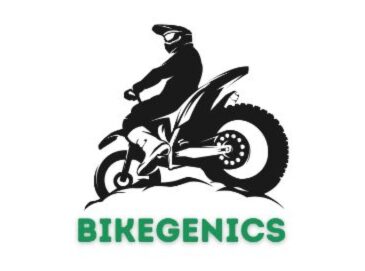


Welcome to Bikegenics, where passion meets performance! We are a leading online destination for all things related to mountain biking, dedicated to providing you with top-notch gear, expert advice, and an immersive community to fuel your two-wheeled adventures. With a commitment to excellence and a deep love for the sport, we strive to elevate your biking experience to new heights.
